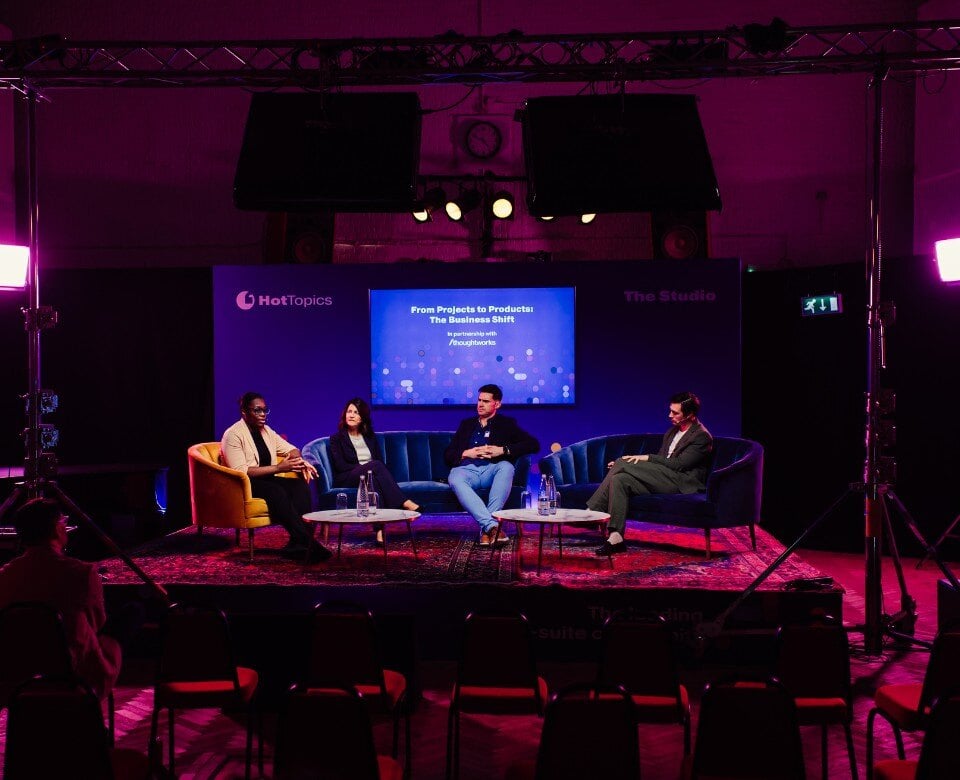
The project vs product mindset: Transforming business strategies

Kani Talabani
Explore the transformative shift from project-led to product-centric strategies discussed by senior technology leaders at The Studio.
In today’s post-pandemic, digital age, organisations are increasingly moving away from project-led to product-centric strategies that emphasise the values of agile development, user-centric design and cross-functional teams that are better equipped to accelerate product delivery.
In this session, the panellists discussed how, by becoming product-led, businesses are better able to adapt to market needs and drive customer satisfaction and growth through continuous innovation and adaptation. The conversation will also share insights tailored for CIOs and CTOs on how to optimise tech stacks, foster cross-functional collaboration and embrace agile methodologies.
Meet the panellists: From projects to products
With Peter Stojanovic moderating, the panellists included:
- Elizabeth Akorita, Group Deputy Director, Digital, Department for Science, Innovation and Technology
- Joanna Pamphilis, Global Head of Investments and Securities Digital Products, CIO, UniCredit
- Andy Birds, Customer Experience Strategy Lead (Europe), Thoughtworks
Watch the full roundtable for 'Projects to Products: The Business Shift'
From projects to products: Key takeaways
- Elizabeth Akorita discussed the shift towards a more product-centric approach in the Department for Science, Innovation and Technology, driven by standards set by the central Government. “What that looks like for us It's not only upskilling and empowering people to work in the way that we would like, but it involves putting our money where our mouth is.”
- Joanna Pamphilis explained the transition at UniCredit towards a product-driven organisation with a focus on vision, agile methodologies and mindset shift. “It's kind of a transaction from a product view standpoint. You're not focused on delivering those features, you're focused on the vision of the product and you have that end-to-end mindset.”
- Andy Birds explained that Thoughtworks has been undergoing a transformative shift internally for years. There is a further emphasis on understanding and addressing the customer’s needs as well as being responsive and delivering value quickly. “If a company can be more responsive, the value to customers is going to get higher market valuation.”
- Emphasising the importance of aligning budget with the strategic goals, Elizabeth argued this is necessary in order to transition to a product-centric approach effectively. “We have a multi-disciplinary teams, we have tech people working with non-tech people and imparting those ways of working.”
- Joanna discussed the challenges faced during the transition to a product-centric approach, highlighting the need for alignment between IT and business teams. “You've got to have somebody on the IT side, somebody on the business side, and then the team follows.”
- Andy considered the “trend” in the business world towards product-centric strategies, often referred to as “product-led growth.” He also mentioned the rise in Chief Product Officers, with an estimated shift from 15 percent to 75 percent of companies gaining a CPO in the next five years.
- Joanna explored the uncertainty and dynamics of “projects to products” orientation within organisations. Highlighting the unpredictability of future trends, such as the rise of generative AI, she shared her views on the advantages and limitations of product-focused approaches. While a purely product-oriented approach has many benefits, a hybrid model may be more practical in certain contexts.
- Organisations under pressure tend to revert to familiar methods such as project-based approaches, rather than maintaining a “product-centric” mindset. Elizabeth elaborated on the behaviour of organisations, sharing her own experience in central government. “We choose to work in a product-centric mindset… with some good governance around it that ensures we're building the right things for the right people in the right place.”
- Andy elaborated on the “controversial point” regarding when to choose projects over products. He suggested that if the requirements are well-known and the organisation is playing catch-up, projects can be more suitable. This is especially true in scenarios like responding to regulatory changes, legal requirements, or migrations where feature parity is needed.
SUBMIT A COMMENT
RELATED ARTICLES
Success isn’t metrics, it’s people: Leadership and life with Sarah Roberts
14 Jan 2026
Join the community
To join the HotTopics Community and gain access to our exclusive content, events and networking opportunities simply fill in the form below.